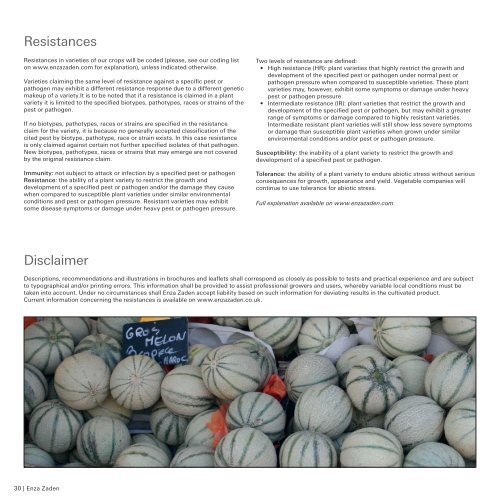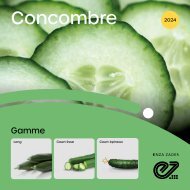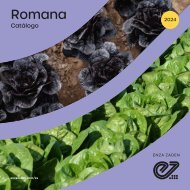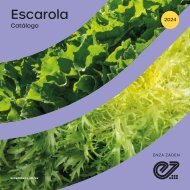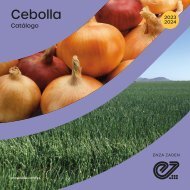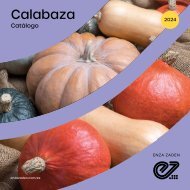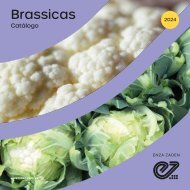Melon 2018
You also want an ePaper? Increase the reach of your titles
YUMPU automatically turns print PDFs into web optimized ePapers that Google loves.
Resistances<br />
Resistances in varieties of our crops will be coded (please, see our coding list<br />
on www.enzazaden.com for explanation), unless indicated otherwise.<br />
Varieties claiming the same level of resistance against a specific pest or<br />
pathogen may exhibit a different resistance response due to a different genetic<br />
makeup of a variety.It is to be noted that if a resistance is claimed in a plant<br />
variety it is limited to the specified biotypes, pathotypes, races or strains of the<br />
pest or pathogen.<br />
If no biotypes, pathotypes, races or strains are specified in the resistance<br />
claim for the variety, it is because no generally accepted classification of the<br />
cited pest by biotype, pathotype, race or strain exists. In this case resistance<br />
is only claimed against certain not further specified isolates of that pathogen.<br />
New biotypes, pathotypes, races or strains that may emerge are not covered<br />
by the original resistance claim.<br />
Immunity: not subject to attack or infection by a specified pest or pathogen<br />
Resistance: the ability of a plant variety to restrict the growth and<br />
development of a specified pest or pathogen and/or the damage they cause<br />
when compared to susceptible plant varieties under similar environmental<br />
conditions and pest or pathogen pressure. Resistant varieties may exhibit<br />
some disease symptoms or damage under heavy pest or pathogen pressure.<br />
Two levels of resistance are defined:<br />
• High resistance (HR): plant varieties that highly restrict the growth and<br />
development of the specified pest or pathogen under normal pest or<br />
pathogen pressure when compared to susceptible varieties. These plant<br />
varieties may, however, exhibit some symptoms or damage under heavy<br />
pest or pathogen pressure.<br />
• Intermediate resistance (IR): plant varieties that restrict the growth and<br />
development of the specified pest or pathogen, but may exhibit a greater<br />
range of symptoms or damage compared to highly resistant varieties.<br />
Intermediate resistant plant varieties will still show less severe symptoms<br />
or damage than susceptible plant varieties when grown under similar<br />
environmental conditions and/or pest or pathogen pressure.<br />
Susceptibility: the inability of a plant variety to restrict the growth and<br />
development of a specified pest or pathogen.<br />
Tolerance: the ability of a plant variety to endure abiotic stress without serious<br />
consequences for growth, appearance and yield. Vegetable companies will<br />
continue to use tolerance for abiotic stress.<br />
Full explanation available on www.enzazaden.com<br />
Scientific name pathogen ISF English name Code Races/Strains Level of resistance<br />
Viruses<br />
Cucumber green mottle mosaic virus Cucumber green mottle CGMMV<br />
Cucumber mosaic virus Cucumber mosaic CMV IR<br />
Cucumber vein yellowing virus Cucumber vein yellowing CVYV<br />
Cucurbit yellow stunting disorder virus Cucurbit yellow stunting disorder CYSDV<br />
<strong>Melon</strong> Necrotic Spot Virus <strong>Melon</strong> necrotic spot MNSV HR<br />
Moroccan watermelon mosaic virus Moroccan watermelon mosaic MWMV<br />
Papaya ringspot virus Papaya ringspot PRSV IR<br />
Squash leaf curl virus Squash leaf curl SLCV<br />
Squash mosaic virus Squash mosaic SqMV<br />
Watermelon mosaic virus Watermelon mosaic WMV IR<br />
Zucchini yellow mosaic virus Zucchini yellows ZYMV IR<br />
Disclaimer<br />
Descriptions, recommendations and illustrations in brochures and leaflets shall correspond as closely as possible to tests and practical experience and are subject<br />
to typographical and/or printing errors. This information shall be provided to assist professional growers and users, whereby variable local conditions must be<br />
taken into account. Under no circumstances shall Enza Zaden accept liability based on such information for deviating results in the cultivated product.<br />
Current information concerning the resistances is available on www.enzazaden.co.uk.<br />
Fungi<br />
Didymella bryoniae Gummy stem blight Db<br />
Fusarium oxysporum f.sp. melonis Fusarium wilt Fom 0 HR<br />
Fusarium oxysporum f.sp. melonis Fusarium wilt Fom 1 HR<br />
Fusarium oxysporum f.sp. melonis Fusarium wilt Fom 2 HR<br />
Fusarium oxysporum f.sp. melonis Fusarium wilt Fom 1,2 IR<br />
Pseudoperonospora cubensis Downy mildew Pcu<br />
Golovinomyces cichoracearum (ex. Erysiphe cichoracearum) Powdery mildew Gc 1 IR<br />
Podosphaeria xanthii (ex Sphaerotheca fuliginea) Powdery mildew Px 1 IR<br />
Podosphaeria xanthii (ex Sphaerotheca fuliginea) Powdery mildew Px 2 IR<br />
Podosphaeria xanthii (ex Sphaerotheca fuliginea) Powdery mildew Px 3 IR<br />
Podosphaeria xanthii (ex Sphaerotheca fuliginea) Powdery mildew Px 5 IR<br />
Podosphaeria xanthii (ex Sphaerotheca fuliginea) Powdery mildew Px 3.5 IR<br />
Insects<br />
Aphis gossypii Cotton aphid Ag IR<br />
30 | Enza Zaden 31 | Enza Zaden


